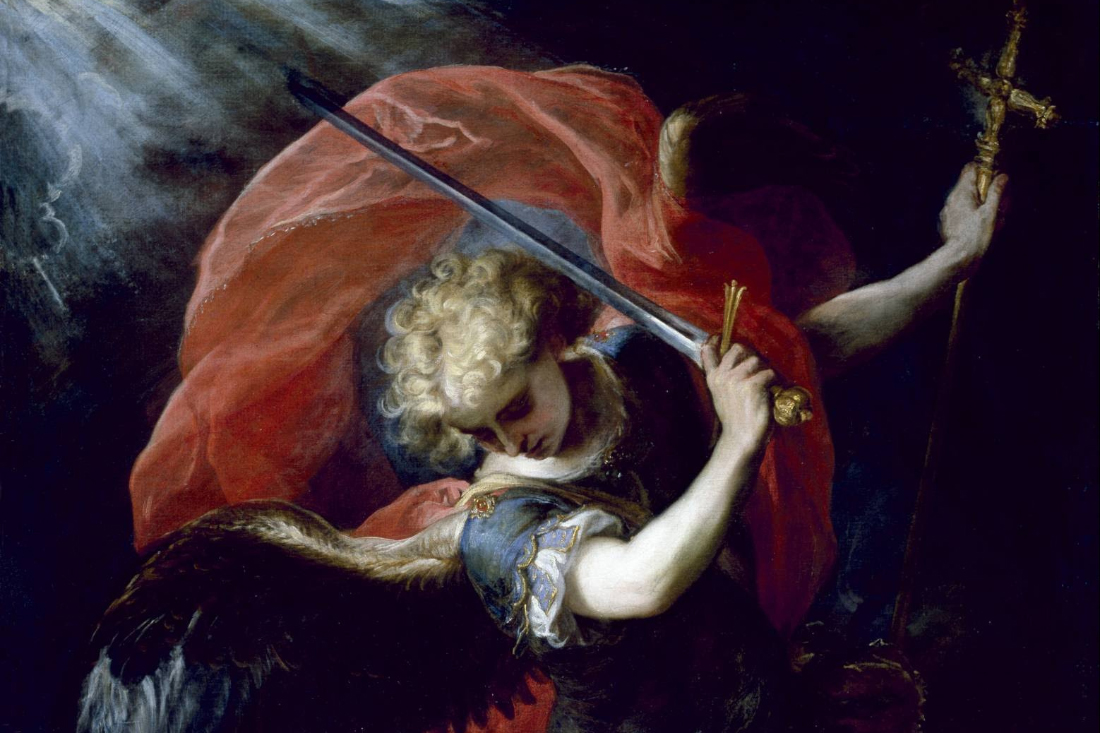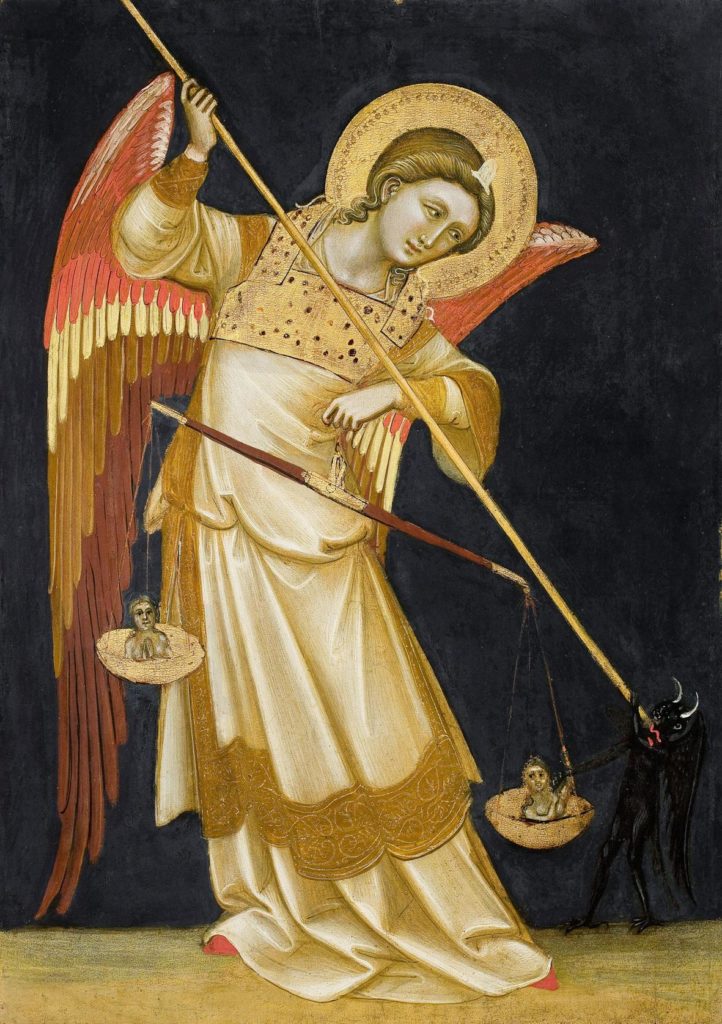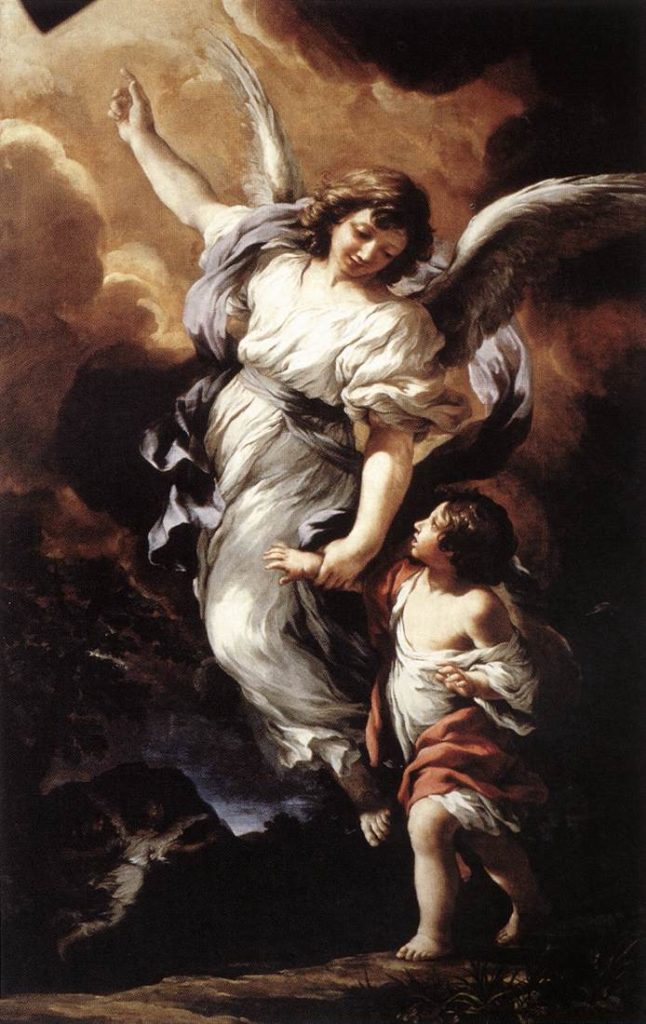
La Gloria di Dio risplende negli angeli
(The glory of God shines in the angels)
—Roman Missal

In the past few years there has been a renewed interest in the period of the liturgical year known, historically, as the Lent of St. Michael, or St. Michael’s Lent. There seems to be a hunger for more information about this devotional practice but an online search turns up very little, outside of a few passages related to the life of St. Francis of Assisi. This essay aims to offer some insight into the historicity of St. Michael’s Lent, as well as provide some ideas for renewing this spiritual practice and incorporating it into our celebration of the liturgical year.

Michael in the Bible
To truly understand the historical context of St. Michael’s Lent it is necessary to examine the cult of St. Michael—from its origins in the ancient Near East to its rapid growth in the West during the Middle Ages—beginning with Michael’s presence in the Bible.
The references to Michael in the Old Testament are few, but not insignificant. The Book of Daniel mentions Michael by name, calling him “one of the chief princes”1 and “the great prince, guardian of your people.”2 Daniel also establishes Michael’s guardianship over Israel—a relationship that was important to the early Church fathers.3
The New Testament writers, in contrast to those of the Hebrew Scriptures, incorporated angels far more frequently in their work. The Greek word angel (aggelos) can be found 175 times in the New Testament.4 Michael appears by name in both Revelation, when he fights against the dragon,5 and the Book of Jude, when he tussles with the devil over the body of Moses—it is here that he is called archangel (archaggelos), translated as “commander-angel.”6
Angels in Late Antiquity
In the centuries after the New Testament was written, there was variance in beliefs among groups of Christians. The fourth century saw much debate among theologians, as they attempted to establish doctrine and centralize power in the newly-legal Christian religion adopted by Emperor Constantine.7 The Nicene theologians saw Christ, the Son, as consubstantial (of one being) with God the father, whereas the Arians saw the Son as subordinate to the Father, a created being and somewhat angelic in nature.8
Discussions surrounding the natures of Christ and the angels continued until late in the fourth century, at which point it was established that Christ was Lord, equal to the Father in every way, begotten not made, and definitely not an angel. Around this time Michael’s title archistrategos (archangel) was also established.9
Michael was becoming more important to Christian theologians, but angel cults existed in the ancient Mediterranean world long before the advent of Christianity. Even in the fourth century, devotion to angels displayed characteristics of various theological streams: Christian, Gnostic, Jewish, and pagan.10 Shrines dedicated to Michael proliferated,11 and he was often invoked in the context of magic “spells.”12
These types of activities were, of course, condemned by the Church,13 which sought to standardize devotional practices in line with its teachings.14 By the end of the fourth century angels were officially incorporated into liturgical settings, with Church leaders in Anatolia referencing them in homilies and consecrating churches in the name of Michael the Archangel.15 Michael gained the title saint,16 and Michaeline churches appeared for the first time outside of the eastern Mediterranean in places like Egypt and Syria.17
East to West
The cult of St. Michael had been growing in the East for some time when—in the fifth, sixth, and seventh centuries—it spread to the West by way of Italy.18 Southern Italy became an important center of devotion to St. Michael, particularly Monte Gargano19 where he is said to have appeared in the sixth century, leaving behind nothing but the imprints of his feet set in stone.20
There is a legend that Sts. Michael, Gabriel, and other Holy Angels would gather to celebrate a mass once a week at midnight in the grotto chapel at Monte Gargano. Emperor Henry II, wishing to witness this miracle, decided to hide in the sanctuary. The angels did come that night, and during the mass Henry was discovered and invited to kiss the Gospel book. In exchange for this honor, he was struck lame and remained that way for the rest of his life.21

The Changing Image of St. Michael
Henry II was just one of many emperors and kings seeking Michael’s protection and favor, and the saint’s popularity only grew over time as these powerful men passed their devotion to him down the generations. The cult of St. Michael got another big boost in the eighth and ninth centuries when Charlemagne and his successors promoted it. St. Michael began to be seen not just as a militant guardian, but also as a heavenly messenger, the master of the cura animarum (care of the soul) and bearer of the souls of the dead.22
In the tenth through the twelfth centuries, Michael’s popularity surged in Western Europe. Sanctuaries, churches, and shrines dedicated to St. Michael appeared on hilltops all over the countryside.23 It was during this time that some of the best-known centers of Michaeline devotion were built. St. Michael was increasingly seen as a personal protector—influenced in part by the Celtic tradition that saw St. Michael as a soul mate—and images from this time period often depict St. Michael holding scales of Judgement.24
Enter: Francis of Assisi
It was into this medieval world, so in love with St. Michael, that Francis of Assisi was born near the end of the twelfth century. The son of a merchant, St. Francis could have lived a life of relative luxury—and he did for a period of time—but instead ended up devoting himself to God and to pursuing poverty as a way of life.
As a young man, Francis struggled to discover his path in life. Seeking conversion, he found himself at the church of San Damiano in Assisi, Italy. While he was praying, he heard Christ speak to him from the crucifix, saying “Francis, repair my church.”
Thinking God meant for him to rebuild the physical church he was praying in, Francis sold items from his father’s shop (without permission) in order to finance the repairs. His father was so angry at this act that he dragged Francis before the bishop and said he must give back the money and renounce his inheritance. That is exactly what Francis did—in fact, he was elated at the prospect.25
From that point on, Francis lived in absolute poverty, even earning himself the moniker poverello (little poor man). His fervor and faith attracted many to him, and a brotherhood of like-minded companions formed around him26 professing obedience, chastity, and poverty.27 They spent their days praying, preaching, and doing their best to make poverty a holy vocation.
Francis and the Angels
Shortly after his conversion, Francis worked to rebuild three crumbling churches in the area around Assisi, including one consecrated to Saint Mary of the Angels. Francis believed this church was particularly favored by the angels and made his home there out of his reverence for them.
Indeed, Francis’s love for the angels was lifelong and profound. St. Bonaventure, a Franciscan bishop and leader of Francis’s order, the Friars Minor, wrote extensively about the life of St. Francis and repeatedly pointed out Francis’s devotion to the Holy Angels. In one passage Bonaventure wrote,
[Francis] was joined by a chain of inseparable love to the angels . . . Because of his devotion to the angels he used to fast and pray constantly during the forty days after the Assumption of the glorious Virgin. Because of the fervent zeal he had for the salvation of all, he was devoted with a special love to blessed Michael the Archangel, who has the office presenting souls to God.28
The Lent of St. Michael
The passage above is one of several references to Francis’s practice of keeping St. Michael’s Lent found in Bonaventure’s “Major Life,” so it is clear that this spiritual practice was both important and ongoing for Francis. St. Bonaventure also noted, “[Francis] had an unshakeable love for the Angels . . . [and] each year he fasted and prayed in their honor for forty days from the feast of the Assumption.”29 It was at the end of the Lent of St. Michael in 1224 A.D. that Francis received the stigmata.30
Despite its importance to Francis, St. Michael’s Lent was just one of many periods of fasting and prayer in which the saint was engaged throughout the year. In addition to the Lent ahead of Easter and St. Michael’s Lent, Francis also fasted and prayed from the Feast of All Saints (November 1st) to Christmas, called the Christmas Fast; for forty days starting at the Epiphany (January 6th), called the Benedictus Fast; and for forty days ahead of the Feast of Sts. Peter and Paul (June 29th), called the Fast in Honor of Peter and Paul; from the end of the Fast of Peter and Paul to the Assumption (August 15th), called the Fast in Honor of Mary.31

Not for the Faint of Heart, or the Laity
His extremely intense devotional schedule would result in Francis having just the month of October and a few weeks scattered throughout the year when he was not fasting. Of all these fasts, St. Francis established just two that he felt were appropriate for the laity:32 The Lenten Fast before Easter, and the Christmas Fast, from the day after Martinmas (November 12th) to Christmas (see St. Martin’s Lent).
Francis knew that most of his fasts were not necessary or appropriate for all Christians—decades of intense fasting had resulted in illness and even blindness for Francis, an injury from which he never fully recovered. Though he suffered greatly, it was during his final illness that Francis wrote his “Canticle of the Sun,” a beautiful expression of his love and gratitude for God and all Creation.33
Though ultimately leading to his death, extreme self-denial was central to the life of St. Francis, and in some ways unique to both the man and the time and place in which he lived. There does not appear to be any readily available sources, outside of works on the life of Francis, which mention a forty-day period of fasting in advance of the Feast of St. Michael, even though devotion to Michael and the Holy Angels was, and still is, widespread. Perhaps St. Michael’s Lent originated with Francis and his order, or it was not popular enough to warrant comment elsewhere.
The Personal is Universal
Even if they weren’t all fasting in honor of St. Michael, Francis’s fellow medieval Catholics did believe that each soul was endowed with a personal guardian angel, a concept that traces its origins to the Bible. In Matthew’s gospel, Jesus seems to affirm the existence of guardian angels when he says, “See that you do not despise one of these little ones, for I say to you that their angels in heaven always look upon the face of my heavenly Father.”34
The Church fathers interpreted this passage, among others, to mean that all humans were gifted with a personal guardian angel at birth, a celestial being to protect, guide, and intercede on their behalf throughout their lives. By the end of the Middle Ages there were liturgical prayers and votive masses for guardian angels (still found in the Roman Missal today), and angels even featured prominently in the books of hours so popular among the laity.35
The average medieval layperson also perceived the workings of angels in their daily lives—attributing successes to angelic intervention and failures to the workings of malevolent spirits. These personal battles between good and evil, they believed, were also being played out on a cosmic level, with St. Michael battling (and eventually vanquishing) Satan and his forces.36
What Does the Church Believe?
Medieval Catholics were mostly right about angels. The Catechism of the Catholic Church affirms that “From infancy to death human life is surrounded by their (the angels) watchful care and intercession. Beside each believer stands an angel as protector and shepherd leading him to life. Already here on earth the Christian life shares by faith in the blessed company of angels and men united to God.”37
However, medieval Christians weren’t right about everything. Case in point: In 2001, the Vatican released its “Directory on Popular Piety and the Liturgy—Principles and Guidelines,” in which it is explicitly stated that both the micro- and macro-cosmic view of angels laid out above is misguided, or at least overly simplistic.
Readers are cautioned to avoid both “the idea that the world is subject to demiurgical struggles, or an incessant battle between good and evil spirits, or Angels and daemons, in which man is left at the mercy of superior forces and over which he is helpless,” and “[ascribing] setbacks to the Devil and all success to the Guardian Angels.”38

Gesturing Toward Renewal
While helping the faithful to avoid angel-related pitfalls, the Holy See’s guidelines also provide the structure for developing a true, spiritually healthy devotion to the Holy Angels based on two principles: Gratitude to God for the gift of the heavenly spirits and their service to man; and devotion arising from the knowledge that God uses his ministers, the Holy Angels, to guide and protect the faithful. The Holy See’s guidelines also encourage individuals and families to pray the Angele Dei during their morning and evening prayers.39
Fasting and prayers of gratitude and devotion in anticipation of the Feast of St. Michael (and another like it, the Feast of Guardian Angels on October 2nd)—in other words, St. Michael’s Lent—would also be perfectly in line with the guidelines given by the Holy See.
If you’re not sure how to express your gratitude in prayer, you could start by thanking God for the many aspects of our lives that are entrusted by the Church to the ministry of the Holy Angels:
- The prayers of the faithful
- The contrition of penitents
- The protection of the innocent from the assaults of the Malign One
- The protection of the faithful as they sleep
- The assistance to the faithful in their last agony
- The accompaniment the souls of the just into paradise
- The watching over of the graves of the just40
Other ways to participate in the prayer aspect of St. Michael’s Lent include praying the Chaplet of St. Michael—a wonderful way to honor him and the other Holy Angels. The Chaplet can also be prayed as a novena starting nine days in advance of the Feast of St. Michael (see Michaelmas). Another option could be a daily or weekly private recitation of the Litany of the Holy Angels or Litany of the Holy Guardian Angel.
If you’re looking for something to read and ponder over during St. Michael’s Lent, or if you’d like to learn more about the life of St. Francis and his devotion to the Holy Angels, I recommend a wonderful collection of stories about him and his Franciscan brothers called The Little Flowers of Saint Francis, translated by Cardinal Manning.
Deepening our faith does not require us to mortify our bodies as severely as St. Francis did to his own, but with him as our guide we can start to imagine how a year imbued with more periods of fasting and prayer could look. A new or renewed devotion to St. Michael and all the Holy Angels may be just what we need to strengthen our relationship with God and deepen our commitment to living the holy life God wants for all of us.

ENDNOTES
1 Dan. 10:13, 21 RSVCE
2 Dan. 12:1 RSVCE
3 Christopher West, “St. Michael the Archangel in Late Antiquity,” (undergraduate honors thesis, 2014), 14
4 West, 15
5 Ibid., 20
6 Ibid., 21
7 Ibid., 26
8 Ibid., 27
9 Ibid., 46-47
10 Ibid., 50
11 Ibid., 61
12 Ibid., 51
13 Ibid., 56
14 Ibid., 61
15 Ibid., 69-71
16 Ibid., 74
17 Ibid., 77
18 Ibid., 79
19 Richard F. Johnson, Saint Michael the Archangel in Medieval English Legend (Woodbridge, UK: The Boydell Press, 2005), 45
20 Paul Oldfield, Sanctity and Pilgrimage in Medieval Southern Italy, 1000-1200 (Cambridge, UK: Cambridge University Press, 2014), 228
21 Johnson, 45
22 Daniel F. Callahan, “The Cult of St. Michael the Archangel and the ‘Terrors of the Year 1000’” in The Apocalyptic Year 1000, eds. Richard Landes, Andrew Gow, and David C. Van Meter (New York, NY: Oxford University Press, 2003), 182
23 Christopher Brooke, The Age of the Cloister (Mahwah, NJ: HiddenSpring, 2003), 245
24 Callahan, 182
25 “Saint Francis of Assisi,” Catholic Online, www.Catholic.org
26 Catholic Online
27 David Keck, Angels and Angelology in the Middle Ages (New York, NY: Oxford University Press, 1998), 125
28 Keck, 124
29 “The Fasts of Saint Francis,” Brothers and Sisters of Penance of St. Francis, www.BSpenance.org
30 Fasts of St. Francis
31 Ibid.
32 Ibid.
33 Catholic Online
34 Mat. 8:10 RSVCE
35 Peter Marshall and Alexandra Walsham, “Migrations of Angels in the Early Modern World” in Angels in the Early Modern World, ed. Peter Callahan (New York, NY: Cambridge University Press, 2006), 10
36 Marshall and Walsham, 11
37 Catholic Church, “The Angels in the Life of the Church,” in Catechism of the Catholic Church (Vatican: Libreria Editrice Vaticana, 2012), paragraph 336
38 “Directory on Popular Piety and the Liturgy. Principles and Guidelines,” Congregation for Divine Worship and the Discipline of the Sacraments, December, 2001, www.Vatican.va
39 Directory
40 Ibid.
Clip art on this page created by elements © StudioDesset; © Jing Cheng, CornerCroft. All other images on this page licensed under CC BY 2.0.
